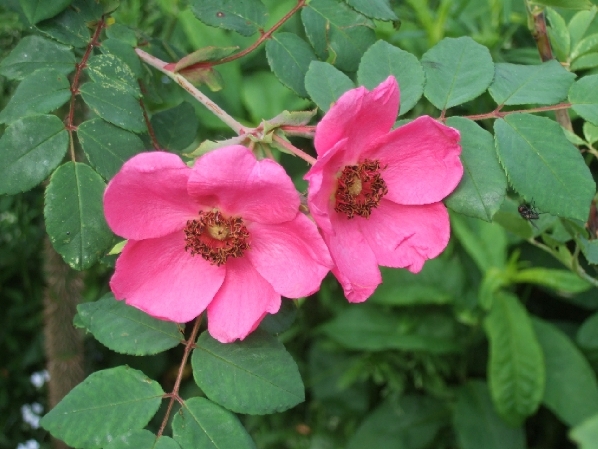Mandarin Rose
(Rosa moyesii)
Mandarin Rose (Rosa moyesii)
/
/

Helena Verghese Borg
CC BY-SA 2.5
Image By:
Helena Verghese Borg
Recorded By:
Copyright:
CC BY-SA 2.5
Copyright Notice:
Photo by: Helena Verghese Borg | License Type: CC BY-SA 2.5 | License URL: https://creativecommons.org/licenses/by-sa/4.0 | Uploader: Epibase | Publisher: Wikimedia Commons |




























Estimated Native Range
Summary
Rosa moyesii, commonly known as Mandarin Rose, is a deciduous shrub native to the forest margins, scrub areas, and open slopes of North-Central and South-Central China, Qinghai, and Tibet. It belongs to the Rosaceae family and is recognized for its vigorous growth, reaching up to 4 meters (13 feet) in height and 3 meters (10 feet) in width. The shrub features an abundance of matte green leaves and bears flat, showy flowers that are red or pink with yellow central stamens, blooming in summer. Following the flowering season, it produces distinctive, bottle-shaped rose hips in autumn, which are both ornamental and a food source for wildlife.
Mandarin Rose is valued for its striking flowers and decorative rose hips, which add interest to the garden throughout multiple seasons. It is often used in ornamental plantings, as well as in breeding programs for its unique characteristics. The cultivar R. moyesii ’Geranium’, with its brilliant orange-scarlet flowers, has been awarded the Royal Horticultural Society’s Award of Garden Merit, indicating its exceptional qualities for garden use. This shrub thrives in full sun but can tolerate part shade, and it is adaptable to a range of soil types, provided they offer good drainage. While generally easy to maintain, it can be susceptible to common rose diseases such as black spot and powdery mildew. Pruning is essential to maintain shape and promote healthy growth.CC BY-SA 4.0
Mandarin Rose is valued for its striking flowers and decorative rose hips, which add interest to the garden throughout multiple seasons. It is often used in ornamental plantings, as well as in breeding programs for its unique characteristics. The cultivar R. moyesii ’Geranium’, with its brilliant orange-scarlet flowers, has been awarded the Royal Horticultural Society’s Award of Garden Merit, indicating its exceptional qualities for garden use. This shrub thrives in full sun but can tolerate part shade, and it is adaptable to a range of soil types, provided they offer good drainage. While generally easy to maintain, it can be susceptible to common rose diseases such as black spot and powdery mildew. Pruning is essential to maintain shape and promote healthy growth.CC BY-SA 4.0
Plant Description
- Plant Type: Shrub
- Height: 5-13 feet
- Width: 3-9 feet
- Growth Rate: Moderate
- Flower Color: Pink, Red
- Flowering Season: Spring, Summer
- Leaf Retention: Deciduous
Growth Requirements
- Sun: Full Sun
- Water: Medium
- Drainage: Fast, Medium, Slow
Common Uses
Bee Garden, Bird Garden, Butterfly Garden, Edible*Disclaimer: Easyscape's listed plant edibility is for informational use. Always verify the safety and proper identification of any plant before consumption., Fragrant, Salt Tolerant, Showy Flowers
Natural Habitat
Forest margins, scrub areas, and open slopes in North-Central and South-Central China, Qinghai, and Tibet
Other Names
Common Names: Moyes Rose , Mandarinros
Scientific Names: Rosa moyesii , Rosa holodonta , Rosa moyesii var. fargesii , Rosa macrophylla var. rubrostaminea , Rosa moyesii var. moyesii , Rosa roseo-moyesii
GBIF Accepted Name: Rosa moyesii Hemsl. & E.H.Wilson